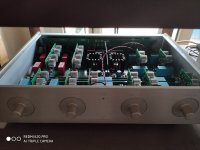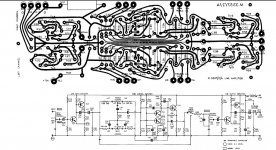I'm partial to this one:
My new preamp design: Arduino, 6 input selector, MDAC attenuator, IR etc
While I haven't used this preamp in particular, this topology is used in the front-end of MC series amps from MC2, and I can say that it's a really, really nice solution. Perfect level matching between channels, and if you use a 12 or 16 bit multiplying DAC, then there won't be any "deciding between steps" like you'd get with a stepped attenuator. I usually don't use a line stage with the MC650, and even with the 8-bit DAC it uses the steps aren't unreasonable.
The nice thing about this solution is that you can be sure that you'll get out exactly what you put in, but with precise level controls.
It would be trivial to add a differential input and line drivers, and then you have a balanced digitally controlled line stage.
My new preamp design: Arduino, 6 input selector, MDAC attenuator, IR etc
While I haven't used this preamp in particular, this topology is used in the front-end of MC series amps from MC2, and I can say that it's a really, really nice solution. Perfect level matching between channels, and if you use a 12 or 16 bit multiplying DAC, then there won't be any "deciding between steps" like you'd get with a stepped attenuator. I usually don't use a line stage with the MC650, and even with the 8-bit DAC it uses the steps aren't unreasonable.
The nice thing about this solution is that you can be sure that you'll get out exactly what you put in, but with precise level controls.
It would be trivial to add a differential input and line drivers, and then you have a balanced digitally controlled line stage.
In terms of the output sounding different from the input; there should not be an audible difference.
Try it sometime with a bypass test, you'll be surprised. Certainly some must prefer the output "version"
of the input or the preamps would not sell, but there should not be a difference.
That's not what i asked you. Which lines stages have build? Which particular ones are you talking about. Be specific, so we know exactly what circuit you mean.
Very serious, that's all you need for CDs. Keep the cables to the amplifier short.
Or you can install the pot inside the power amplifier, which is even better,
and eliminates the extra cable, jacks, and wiring.
For my phono system, I use a 34dB phono stage, 10k switched shunt resistor volume control,
a tube amplifier, and LS3/5As. Even with this system I still have enough volume.
I see, so something like a Professional power amp with gain controls would be idea if it were not for the need to change sources.
I noticed something, I’m not sure if it’s related, with the system I had as a teenager. I used a Toshiba M15/C12 pre power amp combo for my bedroom system and when I got my first decent sound card (The AWE32 if anyone remember) and got a mixer to get enough inputs. Eventually I took the preamp out of the path entirely and the system sounded better with the mixer than the preamp. It was just a simple, cheap Spirit notepad but I remember being confused as to how it sounded noticeably better than the Toshiba pre.
thanksMost recent preamps have a signal routing of source to selector switch to volume control to line stage to power amp.
An input buffer can be overloaded, and is unnecessary. Impedance matching and maximum power transfer do not apply
to preamps (or even ss power amps), since normally they are in voltage mode, where the source z << load z.
my diy cello 1MΩ
This looks better than the original Encore 🙂
Is a circuit available?
This looks better than the original Encore 🙂
Is a circuit available?
The PCB and chassis I bought on taobao.com did not provide the detailed circuit diagram. The components need to be purchased by myself, but most FET and BJT can be purchased in mouser. And I don't know if it can be shipped around the world. But the preamp voice is really good.
For equaliser circuits, Thorsten's impresses me most, till today :
Cello Palette Style EQ Design (was High End Tone Control)...
Cello Palette Style EQ Design (was High End Tone Control)...
A single active circuit for multiple frequency bands.
Can easily be made fully differential.
Patrick
Cello Palette Style EQ Design (was High End Tone Control)...
Cello Palette Style EQ Design (was High End Tone Control)...
A single active circuit for multiple frequency bands.
Can easily be made fully differential.
Patrick
I kinda like Richard Burwens original design as some clever tricks used in it, but simple it aint!
E-Bay currently has a good range of relay input selectors which are really good.
Couple one of those with a good quality ladder attenuator and you probably have as good as it gets.
Audio Input Signal Selector Relay Board/Signal Switching Amplifier Board + RCA | eBay
Couple one of those with a good quality ladder attenuator and you probably have as good as it gets.
Audio Input Signal Selector Relay Board/Signal Switching Amplifier Board + RCA | eBay
Last edited:
Agree. The vast majority of commercial line stages are just atrocious with regards to transparency. Yet, many users prefer sacrificing a large chunk of transparency against more listenable sound.
So true. I've heard a couple receivers from the old days that had decent line level sections. Most are poor.
I have an old Pioneer receiver that I wired around the line level circuitry and put my own in. The power amplifier section is great, but the line level section was terrible.
I even have an old Sony preamp from one of those package deals from the early 90s- separate tuner, preamp, power amp, and speakers sold as a set- and it is audibly inferior to my preamp. The difference is not subtle. Bass is boomy and prominent, everything else is veiled. A line level stage shouldn't do this!
Some people prefer the most transparent sound which always comes out of resistive attenuators.
"Passive" preamps can introduce problems of their own if not carefully applied. Low resistance attenuators (like 10K) can raise the output low frequency pole of the source, which can introduce "boominess" and distortion. And the capacitance of the cables can form a low pass filter with the attenuator (gets worse with higher impedance attenuators) which can also be audible.
So it is a fallacy that a passive preamp delivers the "most transparent sound." It's just not that simple.
Is it the added noise and distortion that makes it more listenable?
No.
Is it the filtering action with digital sources?
No.
Once you move to transistors and add an RF polluting digital source things become more murky.
You can keep that mess out of your circuitry if it's designed properly.
In my experience, two things make a preamp subjectively better than a passive attenuator: buffering and standardized input impedance, which corrects the defects referenced above; and frequency compensation (tone controls, subsonic filters, and sound processors). Of course all this can make it worse if poorly applied.
I know all this goes against purist dogma. But the fact of the matter is that our ears are more sensitive to tonal imbalances, intermodulation distortion, noise, and dynamic deficiencies (compression) than they are to complex harmonic profiles that are 100 dB below the program material.
- Home
- Source & Line
- Analog Line Level
- Which high-end line preamps that we can diy would sound best ?

